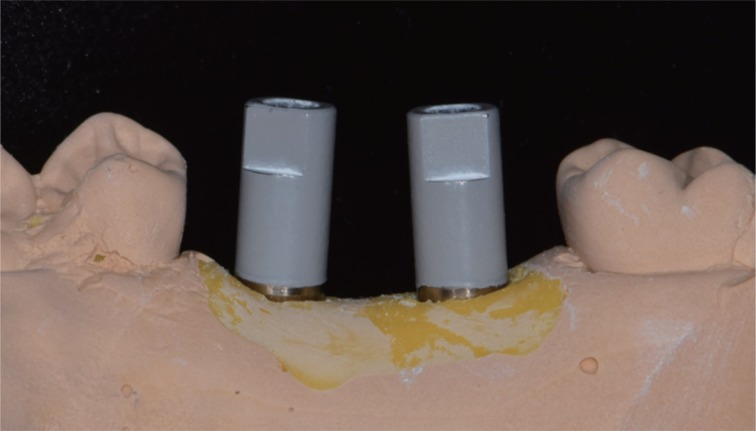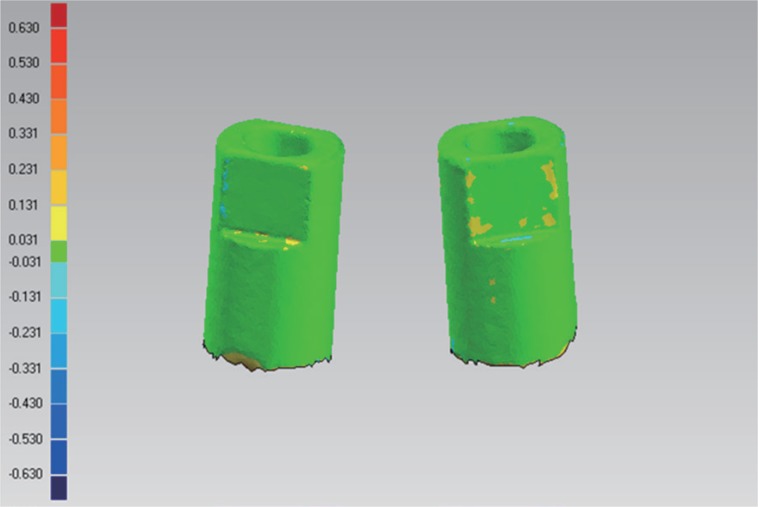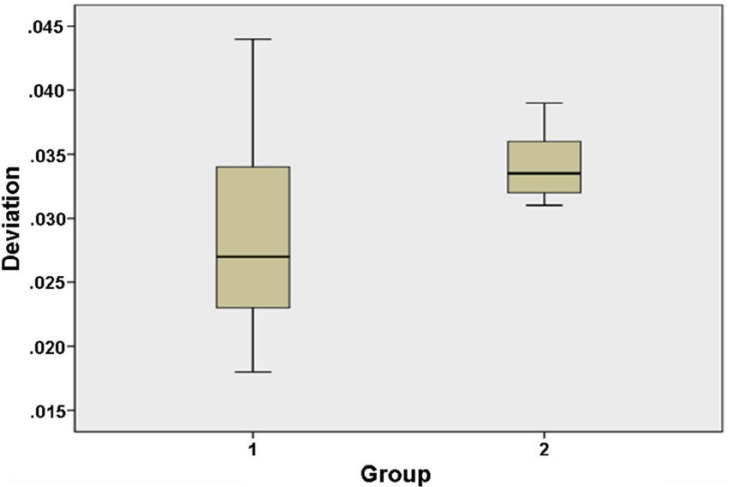J Adv Prosthodont.
2018 Aug;10(4):265-270. 10.4047/jap.2018.10.4.265.
Accuracy of new implant impression technique using dual arch tray and bite impression coping
- Affiliations
-
- 1Department of Prosthodontics, Seoul St. Mary's Hospital, College of Medicine, The Catholic University of Korea, Seoul, Republic of Korea. lsuyoung@daum.net
- 2Department of Conservative Dentistry, Seoul St. Mary's Hospital, College of Medicine, The Catholic University of Korea, Seoul, Republic of Korea.
- KMID: 2418631
- DOI: http://doi.org/10.4047/jap.2018.10.4.265
Abstract
- PURPOSE
The purpose of this in vitro study was to evaluate the accuracy of a new implant impression technique using bite impression coping and a dual arch tray.
MATERIALS AND METHODS
Two implant fixtures were placed on maxillary left second premolar and first molar area in dentoform model. The model with two fixtures was used as the reference. The impression was divided into 2 groups, n=10 each. In group 1, heavy/light body silicone impression was made with pick up impression copings and open tray. In group 2, putty/light body silicone impression was made with bite impression copings and dual arch tray. The reference model and the master casts with implant scan bodies were scanned by a laboratory scanner. Surface tessellation language (STL) datasets from test groups was superimposed with STL dataset of reference model using inspection software. The three-dimensional deviation between the reference model and impression models was calculated and illustrated as a color-map. Data was analyzed by independent samples T-test of variance at α=.05.
RESULTS
The mean 3D implant deviations of pick up impression group (group 1) and dual arch impression group (group 2) were 0.029 mm and 0.034 mm, respectively. The difference in 3D deviations between groups 1 and 2 was not statistically significant (P=.075).
CONCLUSION
Within limitations of this study, the accuracy of implant impression using a bite impression coping and dual arch tray is comparable to that of conventional pick-up impression.
Figure
Reference
-
1. Humphries RM, Yaman P, Bloem TJ. The accuracy of implant master casts constructed from transfer impressions. Int J Oral Maxillofac Implants. 1990; 5:331–336. PMID: 2094651.2. Sahin S, Cehreli MC. The significance of passive framework fit in implant prosthodontics: current status. Implant Dent. 2001; 10:85–92. PMID: 11450418.
Article3. Goodacre CJ, Bernal G, Rungcharassaeng K, Kan JY. Clinical complications with implants and implant prostheses. J Prosthet Dent. 2003; 90:121–132. PMID: 12886205.
Article4. Sones AD. Complications with osseointegrated implants. J Prosthet Dent. 1989; 62:581–585. PMID: 2691663.
Article5. Wee AG, Aquilino SA, Schneider RL. Strategies to achieve fit in implant prosthodontics: a review of the literature. Int J Prosthodont. 1999; 12:167–178. PMID: 10371920.6. Assif D, Marshak B, Schmidt A. Accuracy of implant impression techniques. Int J Oral Maxillofac Implants. 1996; 11:216–222. PMID: 8666454.
Article7. Henry PJ. An alternative method for the production of accurate casts and occlusal records in osseointegrated implant rehabilitation. J Prosthet Dent. 1987; 58:694–697. PMID: 3320351.8. Barrett MG, de Rijk WG, Burgess JO. The accuracy of six impression techniques for osseointegrated implants. J Prosthodont. 1993; 2:75–82. PMID: 8242170.
Article9. Carr AB. Comparison of impression techniques for a five-implant mandibular model. Int J Oral Maxillofac Implants. 1991; 6:448–455. PMID: 1820314.10. Assuncao WG, Filho HG, Zaniquelli O. Evaluation of transfer impressions for osseointegrated implants at various angulations. Implant Dent. 2004; 13:358–366. PMID: 15591998.
Article11. Del'Acqua MA, Arioli-Filho JN, Compagnoni MA, Mollo Fde A Jr. Accuracy of impression and pouring techniques for an implant-supported prosthesis. Int J Oral Maxillofac Implants. 2008; 23:226–236. PMID: 18548918.12. Phillips KM, Nicholls JI, Ma T, Rubenstein J. The accuracy of three implant techniques: a three dimensional analysis. Int J Oral Maxillofac Implants. 1994; 9:533–540.13. Cabral LM, Guedes CG. Comparative analysis of 4 impression techniques for implants. Implant Dent. 2007; 16:187–194. PMID: 17563509.
Article14. Herbst D, Nel JC, Driessen CH, Becker PJ. Evaluation of impression accuracy for osseointegrated implant supported superstructures. J Prosthet Dent. 2000; 83:555–561. PMID: 10793388.
Article15. Naconecy MM, Teixeira ER, Shinkai RS, Frasca LC, Cervieri A. Evaluation of the accuracy of 3 transfer techniques for implant-supported prostheses with multiple abutments. Int J Oral Maxillofac Implants. 2004; 19:192–198. PMID: 15101589.16. Wenz HJ, Hertrampf K. Accuracy of impressions and casts using different implant impression techniques in a multi-implant system with an internal hex connection. Int J Oral Maxillofac Implants. 2008; 23:39–47. PMID: 18416411.17. Carr AB. Comparison of impression techniques for a two-implant 15-degree divergent model. Int J Oral Maxillofac Implants. 1992; 7:468–475. PMID: 1299642.18. Conrad HJ, Pesun IJ, DeLong R, Hodges JS. Accuracy of two impression techniques with angulated implants. J Prosthet Dent. 2007; 97:349–356. PMID: 17618917.
Article19. Parker MH, Cameron SM, Hughbanks JC, Reid DE. Comparison of occlusal contacts in maximum intercuspation for two impression techniques. J Prosthet Dent. 1997; 78:255–259. PMID: 9297641.
Article20. Hsu CC, Millstein PL, Stein RS. A comparative analysis of the accuracy of implant transfer techniques. J Prosthet Dent. 1993; 69:588–593. PMID: 8320644.
Article21. Spector MR, Donovan TE, Nicholls JI. An evaluation of impression techniques for osseointegrated implants. J Prosthet Dent. 1990; 63:444–447. PMID: 2184229.
Article22. Liou AD, Nicholls JI, Yuodelis RA, Brudvik JS. Accuracy of replacing three tapered transfer impression copings in two elastomeric impression materials. Int J Prosthodont. 1993; 6:377–383. PMID: 8240649.23. Rashidan N, Alikhasi M, Samadizadeh S, Beyabanaki E, Kharazifard MJ. Accuracy of implant impressions with different impression coping types and shapes. Clin Implant Dent Relat Res. 2012; 14:218–225. PMID: 19804420.
Article24. Cox JR, Brandt RL, Hughes HJ. A clinical pilot study of the dimensional accuracy of double-arch and complete-arch impressions. J Prosthet Dent. 2002; 87:510–515. PMID: 12070514.
Article25. Parfitt GJ. Measurement of the physiological mobility of individual teeth in an axial direction. J Dent Res. 1960; 39:608–618. PMID: 14430405.
Article26. Goodkind RJ, Heringlake CB. Mandibular flexure in opening and closing movements. J Prosthet Dent. 1973; 30:134–138. PMID: 4515668.
Article27. Ceyhan JA, Johnson GH, Lepe X, Phillips KM. A clinical study comparing the three-dimensional accuracy of a working die generated from two dual-arch trays and a complete-arch custom tray. J Prosthet Dent. 2003; 90:228–234. PMID: 12942055.
Article28. Stimmelmayr M, Güth JF, Erdelt K, Happe A, Schlee M, Beuer F. Clinical study evaluating the discrepancy of two different impression techniques of four implants in an edentulous jaw. Clin Oral Investig. 2013; 17:1929–1935.
Article29. Stimmelmayr M, Erdelt K, Güth JF, Happe A, Beuer F. Evaluation of impression accuracy for a four-implant mandibular model-a digital approach. Clin Oral Investig. 2012; 16:1137–1142.
Article30. Papaspyridakos P, Hirayama H, Chen CJ, Ho CH, Chronopoulos V, Weber HP. Full-arch implant fixed prostheses: a comparative study on the effect of connection type and impression technique on accuracy of fit. Clin Oral Implants Res. 2016; 27:1099–1105. PMID: 26374268.
- Full Text Links
- Actions
-
Cited
- CITED
-
- Close
- Share
- Similar articles
-
- Implant impression using closed mouth impression technique: a case report
- A comparative study on the accuracy of impression body according to the types of impression tray
- Comparative accuracy of implant impression techniques with different splinting materials
- Comparative accuracy of new implant impression technique using abutments as impression copings with an angulated implant model
- A STUDY ON ACCUARACY AND DIMENSIONAL STABILITY ACCORDING TO IMPRESSION METHODS







